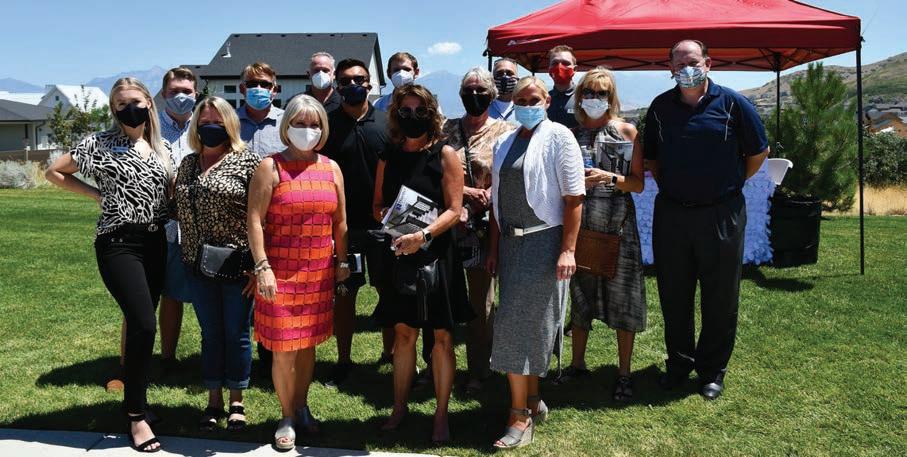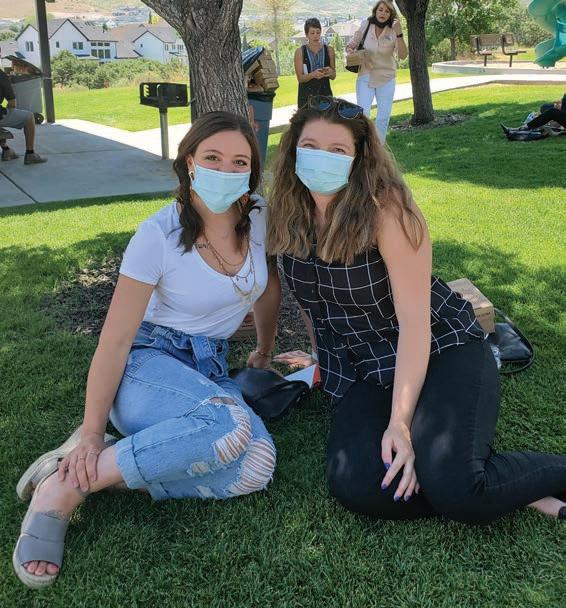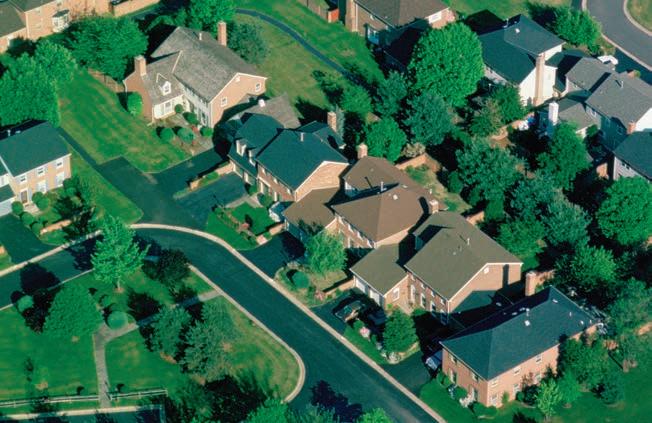
25 minute read
Realtor Day in Herriman
More than 200 Realtors ® and affiliate members gathered in Herriman on July29th for Realtor ® Day at the Cove. The event included a lunch and tour of three homes featured in the Salt Lake Parade of Homes. The event was sponsored by Sage Homes, Salt Lake Parade of Homes, Salt Lake Board of Realtors ® , and Mountain America Credit Union.








Wasatch Front Real Estate Market Heats Up
The Covid-19 pandemic dampened Wasatch Front home sales in April and May. However, the downturn in residential real estate appears to be short lived. One contributing factor is the recordlow mortgage interest rates that are fueling more people to buy homes. Wasatch Front home sales were up 6 percent in this year’s first quarter, but fell 8 percent in the second quarter as the pandemic spread. Overall sales were down just 3 percent in the first six months of 2020 compared to the same period in 2019. In the first half of 2020, there were 18,489 home sales on the Wasatch Front, the third highest number of home sales in a Januarythrough-June period since the MLS started keeping records. Klair Gunn, associate broker with Keller Williams South Valley, said she has never seen anything like today’s market in her 43 years of selling real estate. An agent in her office recently represented a buyer who made an offer of $310,000 on a West Jordan home listed at $289,000. “They were competing with 21 other offers,” Gunn said. “They did not get the home. They were outbid by $10,000.” Gunn said multiple offers are common, especially in the lower price ranges. Even blind real estate
Andy©/ Adobe Stock

offers, where a buyer hasn’t seen the property, are being made. A lack of housing inventory, especially first-time home buyer properties, aggravates the situation. “An agent recently represented a buyer who made an offer of $310,000 on a West Jordan home listed at $289,000. They were competing with 21 other offers. They did not get the home. They were outbid by $10,000.” Klair Gunn
The competition could become more intense as more people migrate to Utah. According to a July article in Forbes magazine, “professionals have begun migrating en masse from America’s biggest cities to urban areas with hot job markets, more affordable costs of living and comparable lifestyles. Additionally, businesses are seeking a break from state income taxes. Many states with great income-to-cost-of-living ratios also have the least tax liability.” Alicia Holdaway, president of the Salt Lake Board of Realtors ® and an agent with Summit Sotheby’s International Realty, said she is currently representing clients moving from California, Arizona, and Maryland. When Covid hit, Holdaway said one of her clients packed up everything and moved from San Francisco to Park City. The client decided to stay in Utah and is currently under contract on a townhome. Urban families spurred by the pandemic are moving out of cities, according to The Wall Street Journal. “This whole thing is catastrophic and petrifying for families in urban areas,” Alison Bernstein, founder and president of Suburban Jungle, a company that specializes in matching city clients with their ideal suburban town, told
Long-Term Rental. No Long-Term Commitment.
Looking for a great alternative to leasing or even purchasing? It’s time to rethink your personal or business transportation needs and try our Long-Term Rental Program. You can choose a new model vehicle for a competitive monthly rate. No cost for preventative maintenance and generous monthly miles are included. Best of all, no long-term commitment.

BudgetUtah.com/long-term-rental | 801-736-4676 | longtermrental@budgetutah.com
©2020 Budget Car and Truck Rental of Utah. A Budget System Licensee.
the Journal. “People want out of the city and now.” Some are prompted by safety concerns. Others worry the shelter-in-place edict will drag on, confining them to small city apartments. A recent survey identified the fastest-growing cities in America. The rankings included: Salt Lake City, Orem, Provo, Sandy, West Jordan, West Valley, Ogden, St. George, and Layton. “These rapid-growth cities have thousands of new arrivals each month who need places to live. As a result, real estate developers — especially multifamily developers — find themselves in one of the hottest markets in decades,” the Forbes article stated. James Wood, Ivory-Boyer Senior Fellow at the University of Utah’s Kem C. Gardner Policy Institute, said new residential building permits

issued in Utah January through May of 2020 set an all-time record. Nearly 12,000 permits were issued in that period, the highest number of new residential permits in a five-month period ever. More than half of those permits were for multifamily units or apartments. Wood added that Covid-19 is not affecting housing prices, but has impacted renters and people employed in the retail, recreation, leisure, health care, and hospitality industries. “I’m continually blown away by the record sales numbers we go over every week,” Holdaway said. “A lot of Utahns are at work and staying at work. There’s a lot of confidence in the market. The interest rates are just mind blowing.” Dave Anderton is the communications director of the Salt Lake Board of Realtors ® .
Scan with your smart phone camera to experience collectionsmedia.com



COLLECTIONSMEDIA .COM
Announcing the launch of Collections Media House, the creative home of Summit Sotheby’s International Realty, our agents and our in-house advertising agency. You’ve seen the globally recognized print publication, now experience the best in curated original content. From films to fashion, interiors to cooking, collectionsmedia.com is the newest innovation from Summit Sotheby’s International Realty, driving traffic to our properties, our sales associates and our developments.
iQoncept©/ Adobe Stock

How the Pandemic Pushed Home Prices to a Record High amid Historic Economic Downturn
The total inventory of U.S. homes on the market is about a third less — roughly 440,000 properties short — than what existed last summer.
By Clare Trapasso
Who would have thought that this summer, with the number of COVID-19 cases surging and new rounds of restrictions and shutdowns, would yield one of the most competitive housing markets in recent memory? Nonetheless, home prices have hit record highs as buyers are battling it out across the nation over a limited selection of reasonably priced abodes. In July, the median home price shot up 8.5 percent year over year, to hit a new all-time high of $349,000, according to the most recent realtor. com ® data. And those mind-boggling high prices, shooting up in the middle of a recession with the worst unemployment since the Great Depression and an economy undergoing a historic contraction, are a direct result of the pandemic. Buyers paid a median $27,000 more for a home in July than they did last year because the supply of available properties for sale plummeted at the same time that demand for them had skyrocketed. This happened despite the economy shrinking by 9.5 percent in the second quarter of the year from the previous one, as the U.S. Commerce Department reported Thursday. Gross domestic product, aka GDP, the value of goods and services produced, dropped the most in the more than 70 years that it has been recorded. “When the pandemic helped tip the U.S. economy into recession, most homeowners and home buyers braced for falling house prices,” said Realtor.com Chief Economist Danielle Hale. “That’s what happened in the last recession. But that’s not what we’re seeing in today’s market. We had a housing shortage already, and the pandemic has created conditions that have only worsened it.” The total inventory of homes on the market is about a third less — roughly 440,000 properties
short — than what existed last summer. In some parts of the country, new home construction was delayed or paused in the spring in the beginning of the pandemic. Meanwhile, many sellers nervous about contracting COVID-19 from buyers touring their homes put off plans to list their residences or pulled them off the market. Many of those listings have yet to go back up. This intensified housing shortage collided with scores of buyers hoping to quarantine in larger abodes and take advantage of the lowest mortgage interest rates ever. Buyers who were sidelined by the virus in the spring are now jockeying with those who had planned to buy in the summer. And they’re competing with those who had no plans to move until the stay-at-home orders created a burning desire for additional square footage and a big backyard in which to ride out the crisis. Record-low mortgage rates have added fuel to the fire as homeownership is now more affordable for buyers. They dipped below 3% for the first time in the week ending July 16, according to Freddie Mac. (They have since ticked up to 3.01% in the week ending July 23.) Those shrunken rates can greatly reduce monthly mortgage payments. The reduced rates are a consequence of the federal government’s actions and the response of investors to the turbulent economy. “We have this market imbalance tipped pretty solidly in favor of sellers at this point,” said Hale. “Yet many homeowners believe that now is still not a good time to sell.” This has led to a return to bidding wars and offers over asking price, which is helping to drive up home prices. And it doesn’t look like they’ll be coming down anytime soon. Prices shot up even more in the latter half of the month, rising a median 9.1% in the weeks ending July 18 and July 25 compared with the previous year, according to realtor.com data. Where are home prices rising the most—and where are they down? Some Northeastern housing markets that were devastated in the spring by the pandemic have rebounded — and then some — as their number of positive cases has fallen. But prices are also up in California and Midwestern cities where the residents are currently being infected at higher rates. Of the 50 largest metropolitan areas, annual prices rose the most in Pittsburgh. Median prices in the Steel City and surrounding area were 25 percent higher in July than the previous year, hitting a median $249,950. Metro areas include smaller towns, cities, and suburbs. These areas outside of the densely packed cities where buyers can get more square footage and outdoor space for their money and have an easier time maintaining social distance have become more popular as the pandemic has dragged on. Pittsburgh was followed by Los Angeles, where prices rose 24.3 percent year over year, to $994,154. Next up was Philadelphia, up 18.5 percent, to $340,000; Cincinnati, up 18.5 percent, to $339,950; San Francisco, up 15.3 percent, to $1,054,210; Cleveland, up 13.5 percent, to $235,050; Boston, up 12.5 percent, to $675,050; Kansas City, MO, up 12.3 percent, to $351,025; Washington, DC, up 11.6 percent, to $529,995; and Providence, RI, up 11.4 percent, to $434,500. “The U.S. housing market performance is closely mirroring COVID[-19]’s path, which is providing clues into what we can expect for various housing markets in the months to come,” Hale said in a statement. “After being particularly hard hit in March and April, new coronavirus cases remain stable in the Northeast and we’re seeing buyers return to the market in force.” Home prices fell in only two of the nation’s 50 largest metros: Miami, where they dipped 1.5 percent compared with last year, and Orlando, FL, where they ticked down 0.9 percent. Median home prices were $403,826 in Miami and $320,050 in Orlando. The Florida cities have been hard-hit by the coronavirus, which may help to explain the declines. Clare Trapasso is the senior news editor of realtor.com and an adjunct journalism professor at the College of Mount Saint VIncent. She previously wrote for a Financial Times publication, the New York Daily News, and the Associated Press. She is also a licensed real estate agent. Contact her at clare.trapasso@ realtor.com.

Dana Keli©/ Adobe Stock

How Your Response to COVID-19 Can Attract Clients
Researchers have developed a five-step guide for managing business relationships during a crisis. Get ideas for how to apply them to your real estate operations. By Melissa Dittmann Tracey
In a relationship-driven business like real estate, it may seem impossible to keep physical distance yet still feel emotionally connected. But practitioners are finding new ways to form bonds with their clients during the coronavirus pandemic and increase their customer pipelines. To do that, take “HEART.” Texas Tech University researchers, as well as professors Ted Waldron and James Wetherbe, developed the HEART framework to guide small businesses through their response to the crisis. The model, which reviews seven decades of business practice and scientific research, consists of the following steps: • Humanize your company • Educate about change • Assure stability • Revolutionize your offerings • Tackle the future
• ‘H’ is for Humanize
Leverage empathy by acknowledging the unique circumstances your past and current customers are facing during this time. Be careful about blending “caring” messages with a sales message, Waldron and Wetherbe noted. Also, don’t be afraid to address the grimness of the current reality. If your business webpage or
marketing doesn’t mention COVID-19 at all, you risk looking irrelevant, Chris Smith, co-founder of the digital marketing company Curaytor, told attendees during a recent realtor.com ® webinar. Reach out to customers in a variety of ways, from sentimental to humorous gestures. Connie and Dan Carlson, founding partners of Ansley Atlanta in Marietta, Ga., launched a “Marietta Strong” blog at their website, promoting a “we are all in this together” message. A video at the site shows community hot spots and local businesses, along with a message of hope, resilience, and unity in the face of COVID-19. Even seemingly small gestures can have a big impact. Brad Inman, founder of Inman News, recently shared how the makings for a dinner treat—chicken and leg of lamb—was unexpectedly left on his doorstep. “It was from my local real estate agent,” he said on a recent podcast. “No card, no expectation, and exactly what I needed. Never before have smart, caring agents proved their value more so than right now.” Fun and humorous ways of connecting may inspire the greatest following. Kristina McCann, broker-owner of Chroma Realty in the San Francisco area, started a ‘mingo’ movement that other real estate professionals in California have replicated. In the evening hours, pros stake out a flock of plastic pink flamingos in people’s yards with “happy birthday” messages for those missing out on special celebrations during the pandemic. The gesture is not about marketing their companies. “My intention was to just spread joy and happiness to people during this time,” said Anthony Marguleas, broker-owner of Amalfi Estates in Pacific Palisades, Calif. “We just wanted to put a smile on people’s faces.” Likewise, Terry Wolak and his alter ego, “The Messy Chef,” are becoming an internet sensation. Wolak, a sales associate with Howard Hanna Real Estate in Penfield, N.Y., shows off his culinary talents in Facebook Live videos shot from his “quarantine kitchen.” His humorous cooking shows also occasionally feature a friend—keeping distance from one another, of course—such as one captured playing a guitar outside his kitchen window. “I think right now people yearn for the humor, the connection, the interaction,” Wolak told Spectrum News about his videos.
Federally Insured by NCUA

HEY REALTORS


FIRST-TIME
NO DOWN PAYMENT 100% FINANCING AVAILABLE!







VISIT US ONLINE AT UCREDITU.COM OR CALL 801.481.8840

‘E’ is for Educate
Share with customers via social media, e-newsletters, and on your website how they can interact with you during the pandemic. Let them know the business changes you’ve made, too. As Chicago issued its stay-at-home orders in March, Erica Cuneen, CIPS, GREEN, broker-owner of Beyond Properties Realty Group, was quick to reach out to customers with weekly emails informing them of how real estate was adapting. The brokerage’s emails detailed in a simple format steps that were being taken among four customer categories: for sellers closing, buyers purchasing, active sellers, and active buyers. Eric Rollo, CIPS, a sales associate with William Raveis Real Estate in Boston, launched a “COVID-19 Resource Hub,” a one-stop website where visitors can learn about health department updates as well as guides on how to access emergency aid. The site culls links on the latest number of coronavirus cases in the Boston area and the state of Massachusetts, homeowner mortgage assistance information, rental assistance and small business help, unemployment aid, and volunteer opportunities.
‘A’ is for Assurance
As the economic and personal toll of the virus mounts, customers may look to companies for assurance. Connie Carlson, associate broker for Ansley Atlanta in Marietta, Ga., posts weekly market snapshots on social media, which include the number of homes listed, under contract, and sold. “We do this to reassure that the market is still continuing on,” said Carlson, who recently listed seven new properties in one week. “Sellers still need to sell, and buyers still need to buy.” Carlson also requires her clients to sign a COVID-19 release form prior to home showings, which she says puts them at ease. The form asks buyers to verify that they aren’t currently ill and to keep their hands in their pockets during tours. Sellers are asked to turn on all lights and open closet doors prior to any showing. “We want to limit how much people have to touch things in the properties,” Carlson said. “We have our clients sign these forms to feel more comfortable that everyone is doing their part to prevent the spread of germs from house to house.”
“Technique often lags behind technology,” Wetherbe said. “The pandemic has forced innovation in doing things differently.” Real estate professionals are using tech tools for showings, such as virtual tours and agent- led video walkthroughs. Carlson is doing a Matterport 3D tour for all her properties, enabling online house hunters to walk through a property virtually, assessing a home in all directions, and even peeking inside closet doors. She’s also holding virtual open houses on Sundays, where online visitors can tune in to livestreams of house tours. Kara Keller, SFR, a broker at Baird & Warner in the Chicago area, is using a drone to show off her listings (video above). She teamed with Doola, a digital marketing company, to send a drone inside properties to capture video footage. Keller then narrates the drone-led video tours and promotes them on the MLS and her website as a way buyers can tour properties remotely.
As your company innovates, look for ways to adopt new processes for the long haul. After all, “some of this technology being embraced could help real estate professionals ultimately sell even more houses in less time,” Wetherbe said. For example, relying on face-to-face showings before the pandemic may have been time-consuming. Now brokerages have developed new ways to virtually show homes and keep people from having to spend time traveling to a property. Businesses should not be quick to abandon new processes once the pandemic is over, the researchers noted. These new ways of doing business could prove to be a differentiator in the future. Companies that are quick to return to older business methods may ultimately fall behind. “I believe the companies that will stand out will be doing things a different way in the future, too,” Waldron said. As businesses sort out the future, the researchers say that a customer-centric attitude and awareness of what people need right now is key. “Companies can emerge from this crisis with strengthened relationships with customers,” the researchers note in an article published in the Harvard Business Review. “Give consumers your HEART during this difficult time. It will cultivate long-lasting goodwill with past customers and help ensure they will stay with you in the future.”
Melissa Dittmann Tracey is a contributing editor for REALTOR ® Magazine. She can be reached at mtracey@realtors.org. Follow her on Instagram and Twitter: @housingmuse. Reprinted from Realtor ® Magazine Online, May 2020, with permission of the National Association of Realtors ® . Copyright 2020. All rights reserved.

Tetra Images©/ Adobe Stock

Don’t Forget the Local Races
Some election races – like the city council – will literally come down to a coin toss. By Marcus Jessop
I remember like it was yesterday. An incumbent councilmember was in a neck-and-neck race against another very good candidate. When the final election results came in, both candidates got exactly the same number of votes. In those rare cases that both candidates receive the same number of votes, the city conducts a recount. Over the next several days, the city counted the votes to determine the winner. Interestingly, after the recount, both candidates were still tied in terms of votes received. Election law states that after an election and recount, if both candidates are still tied, then the election is decided by a game of chance. Both candidates decided to flip a coin to decide the winner, and, as logic would assume, only one candidate came out victorious – the sitting incumbent. I learned an important lesson that day: every vote literally does count. The election season is heating up. Many are aware that election coverage has primarily focused on what is happening at the federal level: the president, members of Congress, etc. This dominant news coverage has led many people to focus on who is running at the top of the ballot and ignore those at the lower end of the ballot.
Take a look at your ballot next time:
• President • Congressional seat candidates • State-wide races (like governor or attorney general) • State Senate and House Races
• Local county races (like county mayor) • State Board of Education or local School Board • Judges There is definitely a lot to vote on this coming election, and it can seem a daunting task to get informed and vote your conscience; however, I know you can do it. We can all make a difference this election season by remembering to vote local!
Down Ballot Elections
Let me go over a scenario that shows how the number of total votes cast decreases as you get further down the ballot. In the 2016 Salt Lake County election, 423,743 ballots were counted for some candidate running for President of the United States. As a reminder, we are only focusing on votes counted in Salt Lake County. The number of votes counted starts to drop as you get into more local elections: • Salt Lake County Mayor: 402,485 votes cast (21,258 fewer votes than the presidential election; a 5% drop) • Salt Lake County at-large: 392,300 votes cast (31,443 fewer votes than the presidential election; a 7% drop). It is even more interesting when you look at the 4 th Congressional District where 230,718 votes were recorded in 2018 - and yet, the two county council districts that represent most of the 4 th Congressional District showed only 92,831 votes 1 . That’s 137,887 fewer votes than votes cast in the 4 th Congressional District race – a whopping 59% drop in down ballot voting! This data indicates that many people are voting for candidates at the top of the ticket, but as you get to the races that are less “media heavy,” voters are not showing up in high numbers like they do at their federal counterparts.
Straight Ticket Voting - Gone
I want to add a short caveat to this discussion. In past elections, straight ticket voting was a way for people to vote for every Democrat, Republican, or other partisan political party on the ballot, without actually filling in the bubble next to every candidate name that is running in that particular political party. This method of voting was overturned by the legislature in the last session. No more voting straight ticket – that’s gone. This means that you have to vote for each individual on the ticket, which, in my estimation, will increase the number of people not voting for lower-balloted candidates. My hope is that after this article is over, you will understand the importance of voting for every candidate down ballot – not just the highprofile races.
All Politics Is Local
You may have heard the phrase that all politics is local. Well, not all politics is local, but a lot of what affects our lives in terms of taxation, school policy, whether a business is deemed essential, etc., all happens at the local level. During the COVID-19 shutdown in Utah, the Salt Lake County Mayor had a lot of discretion on what businesses were deemed essential. Ultimately, the Salt Lake County Mayor deemed real-estate essential. However, the COVID-19 crisis has demonstrated the importance of studying each candidate, federal and especially local, and making sure that your vote counts! Here’s another example. Have you seen your last property tax bill? There’s nothing on there about federal taxes. You might be interested to see that most taxes levied on your property are from the school district, the county, city, sewer, etc. None of those elections are going to draw big numbers like the presidential race, but they have a big impact on your family and finances.
Conclusion
This brings me back to my original story. Every election from presidential to congressional to local races could come down to just a few hundred votes that will decide if your candidate/ party is governing or sitting on the sidelines. Some races – like the city council race – will literally come down to a coin toss. We have a ton of important issues coming up this election; not just taxes and real-estate related issues, but also social issues that have sparked many of the protests we see today. All these issues are usually solved at the local level. Rarely are they decided in the halls of Congress. Don’t stop voting after you vote presidential and congressional races, etc. Keep going! If you are unsure about who to vote for, then ask, research, and take the time to understand the local issues before casting your vote. You can go to vote. utah.gov, enter your address and information, and find which candidate will be on your ballot before you get it in the mail in October. Once again, I want to encourage everyone, whatever your political affiliation, to make your voice heard in 2020! Remember to vote down ballot, and don’t forget those all-important local races.
Marcus Jessop is the government affairs director of the Salt Lake Board of Realtors ® .
Image licensed by Ingram Image
krakenimages.com©/ Adobe Stock

7 Client Behaviors Emerging From COVID-19
The delayed spring market is definitely occurring now in the summer months. By Melissa Dittmann Tracey
As the effects of the pandemic continue, nine in 10 Realtors ® say their housing markets are in recovery mode, with many even saying their markets are hotter now than a year ago, recent member surveys from the National Association of Realtors ® show.
“The delayed spring market is definitely occurring now in the summer months,” said Jessica Lautz, NAR’s vice president of demographics and behavioral insights. The housing market is seeing unprecedented monthly jumps in existing-home sales, and home price appreciation remains strong. Lautz noted several insights, culled from recent NAR research, that show how buyers’ and sellers’ behavior is changing during the coronavirus health crisis. She highlighted those findings at Thursday’s “REvive! From Crisis” virtual conference that featured an all-day lineup of industry leaders and speakers. 1. Buyers are in a rush. Last year, buyers looked at an average of nine homes before making a home purchase. Now, they’re looking at three to four homes before initiating a contract. “Buyers are fast-forwarding their transactions,” Lautz said. Homes are selling in an average of just 24 days. More than a quarter of Realtors ® report their buyers are acting with greater urgency over recent weeks, particularly those making home purchases in rural areas. (continued on page 30)



